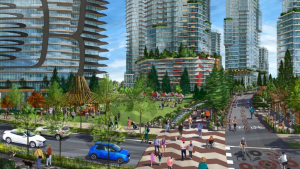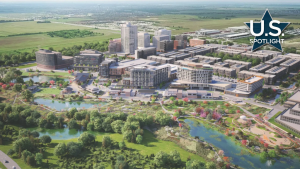In a unanimous vote, Vancouver City Council recently approved the policy statement for the Jericho Lands mixed-use development.
The approval is the first step for a residential-commercial development that will transform a 90-acre site in West Point Grey (WPG), a neighbourhood on the far west side of Vancouver.
It will be one of the largest developments ever undertaken in the city.
Many WPG residents are critical of the current plans, however.
The site is currently home to a former Canadian Armed Forces garrison, several dozen small homes leased to military families and a private school.
The quiet, open area will be transformed into a high-density neighbourhood of residential and commercial structures, some of them very tall.
The policy statement will act as a guide for the project’s future rezoning applications from a partnership of MST Development – the real estate development company owned by the Musqueam, Squamish and Tsleil-Waututh First Nations – and federal crown corporation Canada Lands Company (CLC).
With approval of the policy statement, which is like a site-wide master plan, MST/CLC can move towards making rezoning applications to redevelop the site.
The plan calls for dozens of highrise towers, up to 49 storeys high, plus numerous mid- and low-rise buildings.
There will be space for about 13,000 homes that can accommodate 24,000 residents.
That is almost double the current total WPG population.
In addition, there will be at least 750,000 square feet of office, retail, restaurant, hotel, cultural and “creative industrial spaces” for approximately 3,000 jobs.
There will be room for such amenities as a community centre, libraries, child care facilities and schools.
Following city council’s approval of the policy statement, Matt Shillito, Vancouver’s interim director of planning, said it “established a clear framework for the site to move into the next phase of more detailed planning, while remaining adaptable.”
Jericho Lands has a four-phase, 25- to 30-year development horizon.
“This is a very large, complex project and there is still a lot more technical work to do before construction can start,” Shillito said. “For example, detailed groundwater studies need to be undertaken and the timing and alignment of the UBCX Skytrain (rapid transit) extension (to the University of British Columbia) needs to be confirmed.
“If changes are needed…adjustments will be made to the plan.”
In a post-approval statement, MST/CLC said it will work with the city to advance technical studies, an official development plan and rezoning of the site in four phases.
“It is anticipated that the official development plan process will take the remainder of 2024. Subject to further approvals from Vancouver City Council, we anticipate that construction of phase one could begin in late 2026 or 2027.”
Many residents of WPG, an old, established area of mostly single-family homes, well-kept lawns and tall trees, are not enthusiastic about the Jericho Lands project.
They are concerned about the project’s high density, number of tall buildings, traffic congestion and impact to local services as well as a change for the worse in the neighbourhood’s character.
The Jericho Coalition, a group of neighbourhood volunteers who came together after learning about the MST/CLC proposals, say there are many possible alternatives to the proposals.
“As one of the largest developments in the history of Vancouver, Jericho Lands is an important opportunity to create something great that will leave a lasting legacy for generations to come.”
They say it could deliver “not only more housing, but a livable, sustainable, resilient and human-scale community that responds to the climate crisis…It would lead to a transformative and exemplary urban development that could be a model for the world.”
In a letter to the editor in a Vancouver newspaper, Christina DeMarco, a WPG resident and former urban planner, said, “If you ask people across the wider city or region, they are going to say more housing supply anywhere is good and they will not be expected to offer any wisdom about the local community context. Better solutions will emerge by listening to local concerns.”
DeMarco said the amount of commercial space in the first phase of development should be reduced.
“Why is so much space needed when this neighbourhood will only be a short transit ride away from the three largest employment centres in the region: UBC, central Broadway and downtown?”
She said infrastructure costs could be reduced, too.
“I assume densities are being driven up in part to help pay for infrastructure costs, and SkyTrain would be among the priciest items. If a SkyTrain extension is the most cost-effective way to serve this corridor, what funding formula spreads costs equitably across the region rather than putting an unreasonable burden on… this site?”





Recent Comments
comments for this post are closed